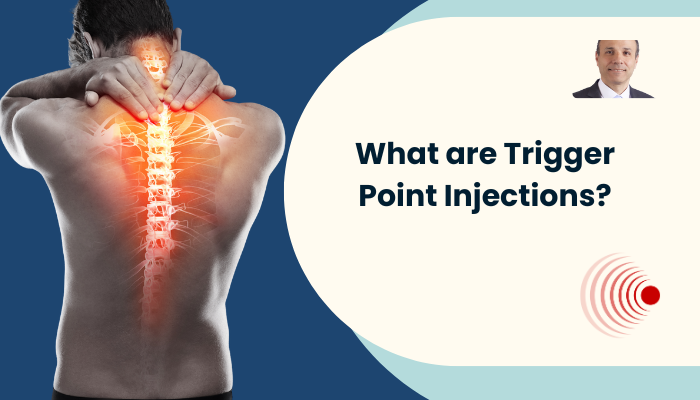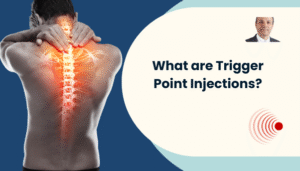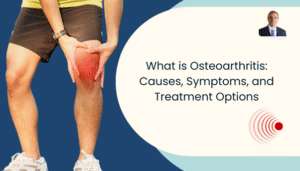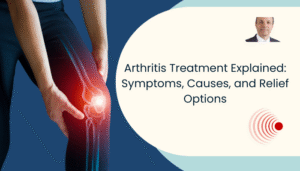What are trigger point injections?

Sometimes, muscle pain can be sharp, shooting, and unbearable, even after following standard remedies. If you have ever had persistent aches, particularly in your neck, shoulders, or back, that are just resistant to medication and rest, you may be dealing with trigger points.
There is an effective treatment option that offers rapid relief- the trigger point injection.
This blog will delve deep into what a trigger point injection is, how it works, and what conditions it can help treat. This will empower you with the knowledge to deal with chronic pain with a scientifically proven and simple treatment comprising trigger point injections, particularly for those involving trapezius trigger points and cervical trigger points.
Understanding Trigger Points
Trigger points are small, tight knots that develop in muscles and fascia (the connective tissue surrounding muscles). Muscle overuse, poor posture, repetitive movements, or injury often cause trigger points.
The knots can be felt under the skin and are painful upon pressing. They may also radiate pain to other areas, a phenomenon called referred pain.
Common areas where trigger points develop include:
- The trapezius muscle around the upper back and shoulders.
- The neck and cervical region, especially in people with desk jobs or poor posture.
- The lower back and hips in athletes and manual labourers.
You might feel the effects of trigger points as stiffness, aching, or even limited movement in the affected muscle group.
What Is a Trigger Point Injection?
A trigger point injection (TPI) is a medical procedure where a healthcare professional inserts a small needle into the trigger point to release muscle tension and reduce pain.
What Medicine Is Used in a Trigger Point Injection?
A TPI may contain:
- A local anaesthetic like lidocaine to numb the area.
- A corticosteroid to reduce inflammation.
- In some cases, saline or dry needling (injection without medicine) may be used.
The choice of medication depends on how severe the condition is, considering the patient’s medical history.
For example, trigger point injections in the neck may use a different formulation than those in the lower back to account for nearby sensitive structures.
When Are Trigger Point Injections Used?
Trigger point injections are typically recommended for individuals who:
- Experience chronic muscle pain that does not improve with rest or trigger point massage.
- Have tried other trigger point therapy methods, like physical therapy, without success.
- Suffer from myofascial pain syndrome or conditions like fibromyalgia.
They are also used to treat cervical trigger point areas in people with tension headaches and pain in the neck and arms.
The Procedure to Administer TPI
Getting a trigger point injection is a quick outpatient procedure and usually takes less than 15 minutes.
Here are the main steps involved in the procedure:
- You’ll lie on an exam table in a relaxed position.
- The doctor will locate the trigger point through palpation.
- The injection site is cleaned, and the medicine is injected directly into the muscle knot.
- You may feel some pressure or minor discomfort, but the procedure is generally well-tolerated.
Patients often experience immediate relief, especially when a local anaesthetic is used.
Benefits of Trigger Point Injections
- Fast relief from localised and referred muscle pain.
- Improved range of motion along with a reduction in muscle stiffness.
- It can help break the pain cycle when used alongside physical therapy.
- It is minimally invasive, with minimal downtime.
Many patients report lasting improvement, particularly when injections are used comprehensively with other treatment options, including posture correction and stretching.
Risks and Considerations
Trigger point injections are considered safe, but like any medical procedure, they may carry small risks, including:
- Bruising at the injection site.
- Temporary soreness or numbness.
- Infection (rare with sterile techniques).
- Allergic reaction to the medication used.
Always discuss your complete medical history with your doctor when you are on medications like anticoagulants or have any bleeding disorders.
Trigger Point Therapy vs Trigger Point Injection
While trigger point massage and manual therapy can provide relief, it is not necessary that they will reach the deep or chronic pain knots.
Trigger point injections offer a more direct approach, particularly useful in long-standing or recurring cases.
Both can complement each other and are often used together in an integrated treatment plan.
FAQs About Trigger Point Injections
It depends on the location and severity of your symptoms. Some patients require a single session; others may need several injections over weeks.
A: Relief can last from days to several months. Combining trigger point therapy or physiotherapy can prolong the benefits.
A: You might feel a pinch or pressure, but most patients tolerate it well.
A: Yes, although some soreness may occur. Light activity and hydration are encouraged after the procedure.
Expert Care by Dr Mohamed El Toukhy
Effective chronic pain management requires expert care. Dr. Mohamed El Toukhy, a leading consultant anesthetist and pain management specialist in Dubai.
His Fellowship and Diploma in Pain Management, as well as other prestigious qualifications and certifications, enable him to follow a comprehensive and evidence-based approach to treating persistent and long-standing pain.
His areas of special interest include:
– Chronic back and neck pain
– Knee and joint pain
– Spinal pain and sciatica
– Neuropathic pain
– Cervical and lumbar pain
– Migraine management
Combining clinical expertise with compassionate care, he customises the treatment plan to relieve his patients’ pain.
If you’re struggling with ongoing discomfort affecting your daily life, it’s time to consult a trusted specialist.
Book your personalised consultation with Dr. Mohamed El Toukhy today and take the first step toward lasting relief.
Related Blogs

What are trigger point injections?
What are trigger point injections? Sometimes, muscle pain can be

What is Osteoarthritis: Causes, Symptoms, and Treatment Options
What is Osteoarthritis: Causes, Symptoms, and Treatment Options As we

Arthritis Treatment Explained: Symptoms, Causes, and Relief Options
Arthritis Treatment Explained: Symptoms, Causes, and Relief Options Break Free

